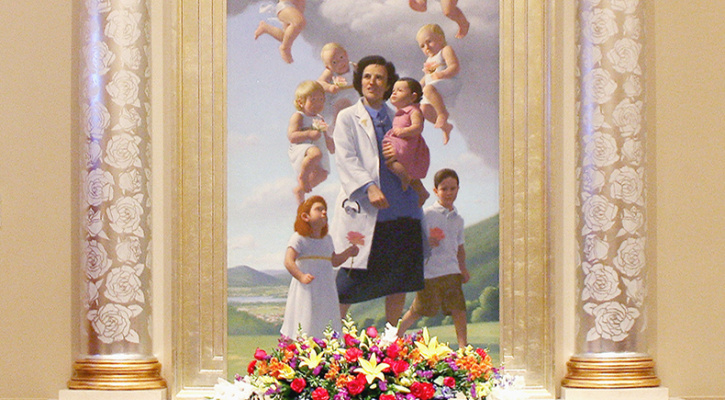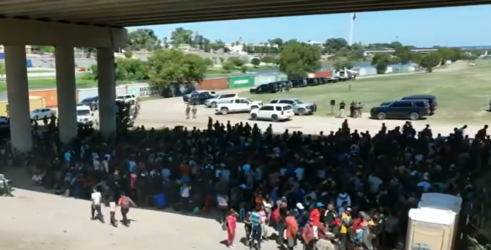Photo: Reppublica Square decorated its streets with huge cubes full of images from John Paul II’s pontificate, including moments from the Mass.
COMMENTARY: When receiving Jesus at Communion, recall the awesome insight of St. John Paul II’s encyclical.
When was the last time you were amazed — really, truly amazed?
Was it during the 2016 World Series, in which the Chicago Cubs, not having won a championship since 1908, won in extra innings in Game Seven?
Or was it during the surprising presidential election that took place just a few days after the Cubs victory?
Perhaps you witnessed last fall’s total solar eclipse or an unexpected rainbow after a thunderstorm.
Maybe it was something personal, such as a miraculous return from sickness to health or the birth of a firstborn child, that astounded you.
Or has it been too many years since you have been amazed?
Fifteen years ago, Pope St. John Paul II made “amazement” the motive force of his encyclical Ecclesia de Eucharistia (The Eucharist in Its Relationship to the Church).
He recalls at the letter’s start how the Paschal Mystery of Jesus is “concentrated” and made perennially present in each celebration of the Eucharist. That is, Jesus’ suffering, death, resurrection and ascension are not lost to the past but are really and substantially present at every Mass.
“The thought of this,” he says, “leads us to profound amazement and gratitude.” And while seeing such sublime truth is a matter of faith, each believer can come to see Jesus’ reality more clearly and be moved to sanctity.
Thus, the Holy Father’s inspiration: “I would like to rekindle this Eucharistic ‘amazement’ by the present encyclical.”
While the encyclical recounts the “usual” amazing Eucharistic truths (it seems incongruous to put it this way!) — the real presence of Jesus, the re-presentation of Calvary’s sacrifice, the foretaste of heaven — there are a number of “extra-amazing” insights worth pondering, truths that can, in the Holy Father’s words, let the Eucharist “shine forth in all its radiant mystery.” Let’s consider three.
Fire Eaters
The impatient among us have experienced that astonishing burn that comes from drinking scalding-hot coffee or taking that first bite of dinner before letting it adequately cool. If you’ve experienced such a thing, bear that memory in mind the next time you receive Communion — for the Pope says the Host is hot!
How so? Pope John Paul cites the deacon and doctor of the fourth-century Syrian Church, St. Ephrem, who wrote of Jesus: “He called the bread his living Body, and he filled it with himself and his Spirit. … He who eats it with faith, eats Fire and Spirit.”
Even the most basic catechetical formation teaches that we receive the Body, Blood, soul and divinity of Christ; but that we receive the Holy Spirit, too — meant to inflame our hearts for love of God — truly amazes our understanding. “Take and eat this, all of you,” St. Ephrem hears Jesus say, “and eat with it the Holy Spirit.”
Prepare to eat Fire the next time you are at Mass and anticipate a personal Pentecost, for “by the gift of his Body and Blood, Christ increases within us the gift of his Spirit, already poured out in baptism and bestowed as a ‘seal’ in the sacrament of confirmation.”
Jesus Receives Communion
St. Paul admonishes communicants to “examine themselves” so as to receive the Body and Blood of Jesus worthily. Consequently, up to our present day, the Church’s ministers have the grave responsibility to prepare first communicants to receive the Eucharist with proper disposition.
Adult communicants receive the Eucharist for the first time at the Easter vigil, while 7- and 8-year-old communicants receive shortly after, usually during the Easter season.
But the Holy Father suggests another communicant.
In addition to adults who receive for the first time at the Easter vigil or young people who receive for the first time during the Easter season, Jesus himself also receives Communion. “We can say not only that each of us receives Christ, but also that Christ receives each of us.” In Communion, Jesus receives you and me.
The “mutual ‘abiding’ of Christ and his followers” taught by the Holy Father has been expressed by numerous saints throughout the ages, among them St. Augustine.
“I am the food of grown men,” St. Augustine hears the Eucharistic Jesus say. “Grow, and you shall feed upon me; nor shall you change me, like the food of your flesh, into yourself, but you shall be changed into me” (see Pope Benedict XVI, Sacramentum Caritatis, 70).
But don’t let that idea go to your head — rather, let it go to your heart. When receiving Jesus at Communion, recall the awesome insight of the Holy Father’s encyclical that Jesus is also receiving you at Communion.
Eucharistic Mother
Some of the Holy Father’s most remarkable insights in Ecclesia de Eucharistia center on that most remarkable of human beings, Mary, the Mother of Jesus.
Just months before his encyclical on the Eucharist, his letter “The Most Holy Rosary” suggested that Mary herself, after a fashion, even “prayed the Rosary”!
The Pope writes, “The memories of Jesus, impressed upon her heart … were to be the ‘Rosary’ which she recited uninterruptedly throughout her earthly life” (Rosarium Virginis Mariae, 11). In his letter on the Eucharist, the Holy Father offers similarly amazing reflections on Mary’s reception of the Blessed Sacrament.
At first, Pope John Paul II draws a number of amazing parallels between Mary’s “reception” of Jesus at the Incarnation and the communicant’s reception of Jesus in the Eucharist.
“At the Annunciation,” he writes, “Mary conceived the Son of God in the physical reality of his Body and Blood, thus anticipating within herself what to some degree happens sacramentally in every believer who receives, under the signs of bread and wine, the Lord’s Body and Blood.” He goes on to compare Mary’s fiat to the communicant’s “Amen”; in both cases, a tabernacle receives Christ and makes him present out in the world.
But even more remarkable than these comparisons is his picture of Mary receiving the Eucharist from the hands of the apostles.
Imagine the scene in which Mary is present at the Breaking of the Bread with Jesus’ first priests:
“What must Mary have felt as she heard from the mouth of Peter, John, James and the other apostles the words spoken at the Last Supper: ‘This is my Body, which is given for you’ (Luke 22:19)? The Body given up for us and made present under sacramental signs was the same Body which she had conceived in her womb! For Mary, receiving the Eucharist must have somehow meant welcoming once more into her womb that heart which had beat in unison with hers and reliving what she had experienced at the foot of the cross.”
The Eucharist is no ordinary food, which is why it can produce extraordinary results in us. Even in — especially in — our Eucharistic practice, Mary is the Mother to guide us.
The Road Goes On
Pope St. John Paul invokes the Eucharistic image of the disciples on the Road to Emmaus in the introduction and the conclusion of his letter. These two nameless disciples are on a journey when they have their eyes opened to Jesus in the Eucharist, and their hearts then move them to proclaim the wonders of Christ’s abiding presence.
There are many amazing truths in the Holy Father’s Ecclesia de Eucharistiabeyond those mentioned here.
Cubs fans, astronomers and first-time parents certainly have every right to be amazed at the blessings they’ve received. But how many of us realize an even greater opportunity for amazement is real and present to us every time we assist at Mass?
Consider this 15th anniversary of Ecclesia de Eucharistia as a grace-filled occasion to be purely amazed by that greatest of gifts, the Eucharist — and through the intercession of Pope St. John Paul II, may our eyes open even wider to Christ.
Christopher Carstens is the director of the Office for Sacred Worship in the Diocese of La Crosse, Wisconsin,
the editor of the Adoremus Bulletin, and a visiting faculty member at the Liturgical Institute in Mundelein, Illinois.







